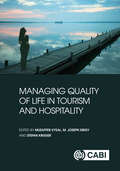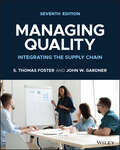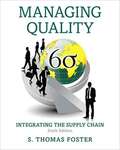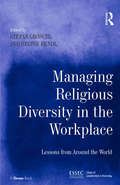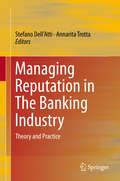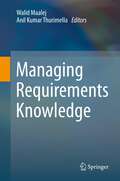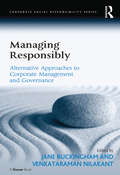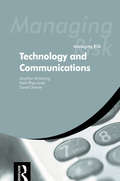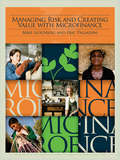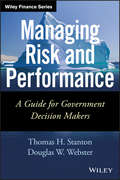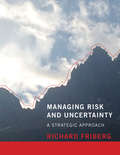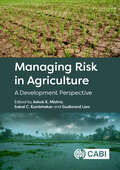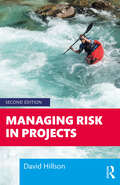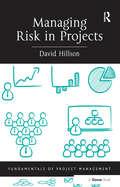- Table View
- List View
Managing Quality in Projects (Advances in Project Management)
by Ron BasuProject managers appear to accept the ’iron triangle’ of cost, budget and quality but in reality focus more on being on time and budget. Quality in projects is often paid mere lip service and relegated to tick-box compliance. This lack of clarity and focus on quality is often the source of project failures. Ron Basu’s Managing Quality in Projects shines the spotlight on this aspect of project management that can often be overshadowed by the pressure to deliver on time and on budget. His investigation focuses initially on defining the dimensions of quality in project management and identifying sources of measurement for project excellence. Thereafter he expands his focus to discuss which tools can be effectively used in the quest for achieving and sustaining project excellence; and which processes are important in assessing the project maturity. The text also explores how the successes of operational excellence concepts, such as supply chain management, Lean Thinking and Six Sigma may be gainfully deployed in enhancing project quality and excellence. Finally a structured implantation plan guides those directly involved in project delivery, including suppliers, in how to ’make it happen’. A shared understanding and implementation of project quality by key project stakeholders will go a long way to ensuring a stable platform for delivering successful projects with longer lasting outcomes. It is also a fundamental building block in any organization’s strategy for improving consistency and achieving sustainable performance. On that basis, Ron Basu’s book is a must-have reference and guide for all project organizations.
Managing Quality of Life in Tourism and Hospitality: Best Practice
by Muzaffer Uysal M. Joseph Sirgy Dr Stefan KrugerQuality-of-life research in tourism and hospitality has gained much momentum in the past two decades. This line of research covers three main areas of focus: (i) the impacts of specific tourism and hospitality programmes on the overall quality of life of tourists/guests; (ii) the providers of goods and services; (iii) tourist communities, including the impact of different programmes and events on the quality of life of residents in these communities. Focusing on these key subjects, Managing Quality of Life in Tourism and Hospitality provides a portfolio of selected cases showing best practice and delivering them to the forefront of knowledge application, with examples in tourism and hospitality settings. Best practice case studies are included throughout, providing practical implications and lessons learned. These lessons can be applied by tourism and hospitality practitioners and community leaders, and be used to further research by academics working within tourism and hospitality. The book offers an exciting and refreshing approach to quality-of-life research in tourism and hospitality. Key features include: - Best practice and evidence-based case studies. - Broad coverage that includes tourists, industry and local communities. - International application, with material from various countries across the world.
Managing Quality of Life in Tourism and Hospitality: Best Practice
by Muzaffer Uysal M. Joseph Sirgy Stefan KrugerQuality-of-life research in tourism and hospitality has gained much momentum in the past two decades. This line of research covers three main areas of focus: (i) the impacts of specific tourism and hospitality programmes on the overall quality of life of tourists/guests; (ii) the providers of goods and services; (iii) tourist communities, including the impact of different programmes and events on the quality of life of residents in these communities. Focusing on these key subjects, Managing Quality of Life in Tourism and Hospitality provides a portfolio of selected cases showing best practice and delivering them to the forefront of knowledge application, with examples in tourism and hospitality settings. Best practice case studies are included throughout, providing practical implications and lessons learned. These lessons can be applied by tourism and hospitality practitioners and community leaders, and be used to further research by academics working within tourism and hospitality. The book offers an exciting and refreshing approach to quality-of-life research in tourism and hospitality. Key features include: - Best practice and evidence-based case studies. - Broad coverage that includes tourists, industry and local communities. - International application, with material from various countries across the world.
Managing Quality: An Essential Guide and Resource Gateway
by David Bamford Ton van der Wiele Barrie G. DaleAn essential quality management resource for students and practitioners alike--now in its sixth edition This popular and highly successful text on Quality Management has been fully revised and updated to reflect recent developments in the field. New to the Sixth Edition is timely coverage of agile development, emerging markets, product research, evidence based decision-making, and quality control. Some of the material has been re-ordered and changes to terminology have been made to bring the book completely up to date. Contributions from new co-author David Bamford offer insights from a veteran teacher and practitioner. A popular resource for students, academics, and business practitioners alike Combines the latest information on quality management system series standards with up-to-date tools, techniques and quality systems Includes insights on quality, operations management, and strategic process improvement Highly relevant for professionals, particularly those involved with reacting to rapid developments in the global market The word "quality" has many definitions, dependent on context and situation. It is often over-used but always in-demand, and it can make or break a business. Quality management is becoming an increasingly vital factor in the success of a product or service, and it requires constant attention and a continuous drive to do better. Managing Quality is a comprehensive resource that helps you ensure - and sustain - high quality standards.
Managing Quality: Integrating the Supply Chain
by John W. Gardner S. Thomas FosterIn the newly revised seventh edition of Managing Quality: Integrating the Supply Chain, a decorated team of operations experts delivers a thorough introduction to quality management with an enduring emphasis on the importance of the supply chain for quality improvement. You'll obtain an integrated understanding of the customers, suppliers, technology, and people essential to maintaining and enhancing product quality in business. This latest edition combines the unifying theme of the supply chain with the latest developments in critical subject areas, like Lean, Six Sigma, and service quality. Updated vignettes and references maintain the currency of the work, while new content expands its scope and increases readability and accessibility for students of operations, quality management, and business.
Managing Quality: Integrating the Supply Chain
by S. FosterFor courses in Quality Management. <p><p> Foster’s Managing Quality: Integrating the Supply Chain, Sixth Edition offers readers a thorough introduction to quality management by presenting a supply chain theme as the unifying framework for quality improvement. The supply chain thread enhances the integration of systems with customers, suppliers, technology, and people. The colorful, stunning text appeals to visual learners and grabs readers’ attention at the outset. <p><p> The Sixth Edition elicits a theme of “currency” while offering updated vignettes and references to remain state-of-the-art. The new edition is selectively edited and enhanced with new content that maintains its scope and withstands pivotal points in each section. Managing Quality keeps a competitive advantage by sustaining and building on cutting edge, relevant topics in quality management.
Managing Religion in the Workplace: Abercrombie & Fitch and Masterpiece Cakeshop
by Derek C.M. van BeverChallenges related to managing religion in the workplace are on the rise, as are religious discrimination claims and monetary settlements, in the United States and around the world. This case examines two incidents of alleged religious discrimination that made their way to the US Supreme Court, allowing students to explore the limits on the degree to which business owners and leaders can express their values through their companies' operations and the extent to which companies should provide reasonable accommodation for employee faith practices.
Managing Religion in the Workplace: Abercrombie & Fitch and Masterpiece Cakeshop
by Derek Van BeverChallenges related to managing religion in the workplace are on the rise, as are religious discrimination claims and monetary settlements, in the United States and around the world. This case examines two incidents of alleged religious discrimination that made their way to the US Supreme Court, allowing students to explore the limits on the degree to which business owners and leaders can express their values through their companies' operations and the extent to which companies should provide reasonable accommodation for employee faith practices.
Managing Religious Diversity in the Workplace: Examples from Around the World
by Stefan Gröschl Regine BendlMany observers propose the exclusion of all religious related aspects from organizational life, others promote a more tolerant approach of certain practices, symbols and ceremonies, and few commentators highlight the values, diverse religious beliefs and experiences that employees could bring to the organization. Arguments, conclusions and recommendations are often contradictory and inconclusive due to the complexity and dividing nature of religion diversity. In Managing Religious Diversity in the Workplace the editors present a selection of essays, conceptual papers, empirical studies and case studies about how religious diversity and spirituality are managed. The book explores how firms address organizational and managerial challenges deriving from the religion diverse backgrounds of their employees. The different contributions discuss policies and practices, how implicit and unmarked religious norms influence the ’managing’ of religious issues in organizations, and what the benefits of a religion diverse workforce are. It also includes contributions which address aspects of spirituality in the workplace, and the role of legal frameworks and their influence on organizations and their policies and practices regarding religion diversity. The perspectives and contributions include a wide range of disciplines by authors from leading academic institutions around the world.
Managing Religious Tourism (CABI Religious Tourism and Pilgrimage Series)
by Razaq Raj Ian Rotherham Alan Clarke Nigel Morpeth Silvia Aulet Kevin Griffin Rong Huang Dr Daniel H Olsen Vreny Enongene Xosé M. Santos Dr Maureen Griffiths Peter Wiltshier Dr Lucrezia Lopez Dr Elisa Piva Stefania Cerutti Dane Munro Dr Maaike De Jong Dr Alexander Grit Xin Lei Hu Sonia Puyol Ramon Canal Esperanca HolgadoManaging Religious Tourism provides a global view of the tools and resources used in demand and supply management, in the context of pilgrimage and religious tourism. With a focus on toolkits and best practices, the book reinforces the quality of service provision and offers a reflection on consumers' perspectives and what drives their purchasing decisions with regards to a variety of destinations. These central themes are complemented by an understanding of management responses to consumer behaviour and mobility, accessibility, individualism and tourism for both sacred and secular purposes. The book also examines the ways in which networks, partnerships and the conceptual stakeholder approach can be employed by religious tourism suppliers working with destination management organisations. The text promotes sustainable development and a triple bottom line focus, with all chapters supporting policy for framing development. Key features include: - Global perspective on tools as well as management approaches and techniques. - Emphasis on sustainability in connecting sacred and secular consumers. - Focus on promoting learning and development within this important tourism sector.
Managing Religious Tourism (CABI Religious Tourism and Pilgrimage Series)
by Razaq Raj Ian Rotherham Alan Clarke Nigel Morpeth Silvia Aulet Kevin Griffin Rong Huang Dr Daniel H Olsen Vreny Enongene Xosé M. Santos Dr Lucrezia Lopez Dr Elisa Piva Stefania Cerutti Dane Munro Dr Maaike De Jong Dr Alexander Grit Xin Lei Hu Sonia Puyol Ramon Canal Esperanca HolgadoManaging Religious Tourism provides a global view of the tools and resources used in demand and supply management, in the context of pilgrimage and religious tourism. With a focus on toolkits and best practices, the book reinforces the quality of service provision and offers a reflection on consumers' perspectives and what drives their purchasing decisions with regards to a variety of destinations. These central themes are complemented by an understanding of management responses to consumer behaviour and mobility, accessibility, individualism and tourism for both sacred and secular purposes. The book also examines the ways in which networks, partnerships and the conceptual stakeholder approach can be employed by religious tourism suppliers working with destination management organisations. The text promotes sustainable development and a triple bottom line focus, with all chapters supporting policy for framing development. Key features include: - Global perspective on tools as well as management approaches and techniques. - Emphasis on sustainability in connecting sacred and secular consumers. - Focus on promoting learning and development within this important tourism sector.
Managing Reputation in The Banking Industry
by Stefano Dell'Atti Annarita TrottaThe topic of reputational crisis in the banking sector has receivedincreasing attention from academics and practitioners. This book presentsexpert contributions that cover three main aspects: first, an extensive reviewof the literature on reputational risk in the banking sector aimed to identifythe relationships between causes, effects, stakeholders, and keyqualitative-quantitative variables involved during the reputational crisis of abank; second, devising a conceptual framework for management of reputational crisisin banking, and finally, testing this framework with the results of anempirical analysis carried out by observing key variables of some known casesof reputational crisis relating to international banks and proposing casestudies regarding the dynamic process of reputation management.
Managing Requirements Knowledge
by Anil Kumar Thurimella Walid MaalejRequirements engineering is one of the most complex and at the same time most crucial aspects of software engineering. It typically involves different stakeholders with different backgrounds. Constant changes in both the problem and the solution domain make the work of the stakeholders extremely dynamic. New problems are discovered, additional information is needed, alternative solutions are proposed, several options are evaluated, and new hands-on experience is gained on a daily basis. The knowledge needed to define and implement requirements is immense, often interdisciplinary and constantly expanding. It typically includes engineering, management and collaboration information, as well as psychological aspects and best practices. This book discusses systematic means for managing requirements knowledge and its owners as valuable assets. It focuses on potentials and benefits of "lightweight," modern knowledge technologies such as semantic Wikis, machine learning, and recommender systems applied to requirements engineering. The 17 chapters are authored by some of the most renowned researchers in the field, distilling the discussions held over the last five years at the MARK workshop series. They present novel ideas, emerging methodologies, frameworks, tools and key industrial experience in capturing, representing, sharing, and reusing knowledge in requirements engineering. While the book primarily addresses researchers and graduate students, practitioners will also benefit from the reports and approaches presented in this comprehensive work.
Managing Responsibly: Alternative Approaches to Corporate Management and Governance (Corporate Social Responsibility)
by Venkataraman NilakantIn the wake of financial meltdown and environmental disaster, employers increasingly demand that managers have an understanding of ethical decision making, corporate social responsibility and values-based management. Business ethics is therefore increasingly being taught in business schools and is a rapidly developing research topic. Managing Responsibly explores the limitations of the thinking that dominates Western corporate and business culture. Contributors then draw on non-Western traditions and experience to suggest workable inter-cultural models to enhance organizational effectiveness in an increasingly globalised environment. With chapters written by specialists in economics, management, ethics, health sciences and history, the editors - one a historian and one a management specialist - ensure a truly interdisciplinary overall approach. Part One highlights the acute need for less self-interested approaches to management if local and global communities and the environment are to escape on-going damage and exploitation. Part Two draws on values from Indian and Maori traditions to propose alternatives to Western models of business ethics. Part Three suggests ways of approaching the challenges of developing sustained ethical leadership in the contemporary globalised economy. This original addition to Gower's Corporate Social Responsibility Series will appeal to a wide range of teachers, researchers and higher level students of management, as well as practitioners participating in executive development programmes. It will also serve the needs of those with a more specialist interest in business ethics and in sustainable and responsible management.
Managing Risk
by Daniel Dresner Jonathan Armstrong Mark Rhys-JonesManaging Risk: Technology and Communications is a practical guide to the effective management of technology and communications risks. Frequent high profile scares, like the Sasser worm and WiFi vulnerabilities, make a proactive approach essential and this book shows you how to put in place expedient checks, balances and countermeasures.Business networks are threatened by a host of factors, from employee abuse to non-compliance with data protection and libel laws, from hacker attacks to viruses and from extortion and terrorism to natural disaster.The costs of failing to manage systems risks can be immense and go beyond simple loss of productivity or even fraudulent losses to brand damage, theft of business secrets, expensive litigation, diminished customer confidence and adverse impacts on personnel and share value. This practical handbook includes examples, checklists and case studies to help you manage such hazards.The book covers:• accessibility of information;• acceptable use of information;• directors’ legal duties;• general legal compliance;• protecting networks from external and internal threats;• encouraging security awareness at management and employee level;• reputational risk management; and• national and international risk and security standards.Managing Risk: Technology and Communications is the indispensable work of reference for IT and technology managers, HR managers, IT legal advisors, company secretaries and anyone seeking practical guidance on technology risks and their management.
Managing Risk and Creating Value with Microfinance
by Mike Goldberg Eric Palladini'Managing Risk and Creating Value with Microfinance' brings together the latest information on microfinance institutional sustainability from leading international experts and microfinance practitioners in four Latin American countries. Each chapter focuses one topic: risk management; good governance; interest rates; microinsurance; housing microfinance; microleasing; disaster preparedness; or new technologies. The papers in the book are the result of a series of meetings financed by the United Kingdom's Department for International Development and supported by the World Bank's Global Development Learning Network. The Bank engaged practitioners in these four countries in response to a movement in some South American governments to impose policies and practices that would, in the long run, reduce the microfinance institutions' (MFIs') sustainability. The meetings were designed to strengthen MFIs by disseminating innovative approaches in the above eight areas, promoting a South-South dialogue, encouraging greater ties between these MFIs, and highlighting the Bank's ability to mobilize international experts and local practitioners. The discussions took place between 2006 and 2008. 'Managing Risk and Creating Value with Microfinance' covers risk management topics such as risk management systems, good governance, interest rates, and microinsurance. The authors present information on new product development and efficient delivery methodologies including housing microfinance, microleasing, disaster preparedness, and new technologies. A Web site (www.dgroups.org) provided a forum for further discussion and knowledge sharing. 'Managing Risk and Creating Value with Microfinance' is intended for MFI board members, managers, and staff, students and professors of microfinance, and government regulators and supervisors.
Managing Risk and Performance
by Douglas W. Webster Thomas StantonDiscover analytical tools and practices to help improve the quality of risk management in government organizationsFederal agencies increasingly recognize the importance of active risk management to help ensure that they can carry out their missions. High impact events, once thought to occur only rarely, now occur with surprising frequency. Managing Risk in Government Agencies and Programs provides insight into the increasingly critical role of effective risk management, while offering analytical tools and promising practices that can help improve the quality of risk management in government organizations.Includes chapters that contribute to the knowledge of government executives and managers who want to establish or implement risk management, and especially Enterprise Risk Management (ERM), in their agenciesFeatures chapters written by federal risk managers, public administration practitioners, and scholarsShowing government officials how to improve their organization's risk management capabilities, Managing Risk in Government Agencies and Programs meets a growing demand from federal departments and agencies that find themselves increasingly embarrassed by risky events that raise questions about their ability to carry out their missions.
Managing Risk and Reward in the Entrepreneurial Venture
by Michael J. RobertsDiscusses techniques entrepreneurs use to manage risk and reward in the early stages of the venture.
Managing Risk and Security in Outsourcing IT Services: Onshore, Offshore and the Cloud
by Frank SiepmannWith cloud computing quickly becoming a standard in today's IT environments, many security experts are raising concerns regarding security and privacy in outsourced cloud environments-requiring a change in how we evaluate risk and protect information, processes, and people.Managing Risk and Security in Outsourcing IT Services: Onshore, Offshore and
Managing Risk and Uncertainty: A Strategic Approach
by Richard FribergA comprehensive framework for assessing strategies for managing risk and uncertainty, integrating theory and practice and synthesizing insights from many fields. This book offers a framework for making decisions under risk and uncertainty. Synthesizing research from economics, finance, decision theory, management, and other fields, the book provides a set of tools and a way of thinking that determines the relative merits of different strategies. It takes as its premise that we make better decisions if we use the whole toolkit of economics and related fields to inform our decision making.The text explores the distinction between risk and uncertainty and covers standard models of decision making under risk as well as more recent work on decision making under uncertainty, with a particular focus on strategic interaction. It also examines the implications of incomplete markets for managing under uncertainty. It presents four core strategies: a benchmark strategy (proceeding as if risk and uncertainty were low), a financial hedging strategy (valuable if there is much risk), an operational hedging strategy (valuable for conditions of much uncertainty), and a flexible strategy (valuable if there is much risk and/or uncertainty). The book then examines various aspects of these strategies in greater depth, building on empirical work in several different fields. Topics include price-setting, real options and Monte Carlo techniques, organizational structure, and behavioral biases. Many chapters include exercises and appendixes with additional material. The book can be used in graduate or advanced undergraduate courses in risk management, as a guide for researchers, or as a reference for management practitioners.
Managing Risk in Agriculture: A Development Perspective
by Jean-Paul Chavas J Brian Hardaker Lu Liu Ricardo Fort Juan Dominguez Fulco Ludwig Tahirou Abdoulaye Rachidi Aboudou Aminou Arouna Victor Barrera Toritseju Begho Marrit Van Berg Pratap S. Birthal Martina Bozzola Selina Bruns Simone Cerroni Marcella D’Souza Ali Essossinam Hongli Feng Jaweriah Hazrana David A. Hennessy Maman H. Karmana Aditya R. Khanal Seo Woo Lee Sergio H. Lence Abel-Gautier Kouakou Alfons G.J.M. Lansink Wanglin Ma Hui Mao Miranda P.M. Meuwissen Digvijay S. Negi Kehinde Odeniyi Asis Kumar Senapati Ariel Singerman Arjuna Srinidhi Ruggiero Rippo Nicholas Tyack Puneet Vatsa Alexis H. Villacis H. Holly Wang Saskia E. Werners Tesfamicheal Wossen Eliana Wulandari Xiaoheng Zhang Hongyun ZhengThe book addresses and documents farmers' risks in developing and emerging economies. It draws lessons from experimental economics on measuring risk preferences, attitudes, gender differences in managing risks, and risk management strategies in countries across Africa and Asia. It argues policy makers, especially in emerging economies, need a better understanding of farmers' attitudes toward risk and choices of risk management strategies when designing policies to support production agriculture. The book includes chapters on three themes: understanding risk attitudes and preferences; using experimental economics to measure risk, preferences, and risk management strategies; and understanding climate change, risk, and risk management. The book critically examines the currently held beliefs about risk preference, attitudes, and empirical estimation of risk management strategies, emphasizing developing and emerging economies (DEE). "The agricultural development space is an inherently risky one and this welcome collection belatedly helps to plug an important hole." Jock R. Anderson, Emeritus Professor of Agricultural Economics, University of New England, Armidale, Australia "Over time, agricultural production practices have evolved, as have the markets and value chains for food and agricultural products. A constant consideration, however, and one that continues to define agriculture worldwide, is risk. The risks that impinge on agriculture come in all shapes and sizes. Of course, production risks are ubiquitous. But so are market risks. And the same is true for macroeconomic and financial risks and the risks associated with an evolving climate. This book will be a valuable, comprehensive resource for any applied economist desiring to understand the risk management principles relevant to modern food and agricultural systems." Matthew Holt, Prof. and head of the Department of Agricultural and Applied Economics, Virginia Tech University, Blacksburg, VA, USA.
Managing Risk in High-Stakes Faculty Employment Decisions
by Terry L. Leap Julee T. FloodUnderstanding the risks involved in hiring new faculty is becoming increasingly important. In Managing Risk in High-Stakes Faculty Employment Decisions Julee T. Flood and Terry Leap critically examine the landscape of US institutions of higher learning and the legal and human resource management practices pertinent to college and university faculty members. To help minimize the potential pitfalls in the hiring and promotion processes, Flood and Leap suggest ways that risk management principles can be applied within the unique culture of academia.Claims of workplace harassment and discrimination, violation of free speech and other First Amendment rights, social movements decrying unequal hiring practices, and the growing number of non-tenure track and adjunct faculty, require those involved in hiring and promotion decisions to be more knowledgeable about contract law, best practices in hiring, and risk management, yet many newly appointed administrators are often not sufficiently trained in these matters or in understanding how they might be applied in an academic setting. Human resource departments, hiring committees, department chairs, and academics seeking faculty jobs need resources such as Managing Risk in High-Stakes Faculty Employment Decisions now more than ever. Outlines critical issues affecting U.S. higher education Analyzes the social and psychological biases that can arise during hiring, promotion, and tenure decisions Discusses contract and constitutional law from the perspective of institutions of higher learning Illustrates complex interactions that shape contractual, constitutional, and collegial issues in institutions of higher learning Examines contract rights and controversies for tenured and tenure-track faculty Describes how risk management processes can help to deal with these complicated, but critical, issues Addresses constitutional issues associated with academic freedom and free speech on campus Investigates the nebulous, but important, issue of collegiality Discusses the future for institutions of higher learning in hiring faculty
Managing Risk in Projects (Fundamentals Of Project Management Ser.)
by David HillsonProjects are risky undertakings, and risk management is recognised as an integral part of managing the project. Managing Risk in Projects places risk management in its proper context in the world of project management and beyond, emphasising the central concepts essential to understanding why and how risk management matters, and presenting proven practical approaches to addressing risk in any project.The risk management world has changed significantly since the first edition, with advances in risk management practice reflected by changes in international standards and guidelines, as well as significant developments in their implementation. This second edition reflects these changes, and has been completely updated to address progress in the practical application of risk management to projects. Two new chapters have been added, the first discussing how to manage risk in complex projects, and the second considering the role and influence of risk leaders outside the project arena in setting the context and environment for successful risk management. New material also addresses enterprise risk management and risky decision-making.Throughout, the book offers a concise description of current best practice in project risk management whilst introducing the latest developments, to enable project managers, project sponsors and others responsible for managing risk on projects to do just that – effectively.
Managing Risk in Projects (Fundamentals of Project Management)
by David HillsonProjects are risky undertakings, and modern approaches to managing projects recognise the central need to manage the risk as an integral part of the project management discipline. Managing Risk in Projects places risk management in its proper context in the world of project management and beyond, and emphasises the central concepts that are essential in order to understand why and how risk management should be implemented on all projects of all types and sizes, in all industries and in all countries. The generic approach detailed by David Hillson is consistent with current international best practice and guidelines (including 'A Guide to the Project Management Body of Knowledge' (PMBoK) and the 'Project Risk Management Practice Standard' from PMI, the 'APM Body of Knowledge' and 'Project Risk Analysis & Management (PRAM) Guide' from APM, 'Management of Risk: Guidance for Practitioners' from OGC, and the forthcoming risk standard from ISO) but David also introduces key developments in the risk management field, ensuring readers are aware of recent thinking, focusing on their relevance to practical application. Throughout, the goal is to offer a concise description of current best practice in project risk management whilst introducing the latest relevant developments, to enable project managers, project sponsors and others responsible for managing risk in projects to do just that - effectively.
Managing Risk of Supply Chain Disruptions (Routledge Advances In Risk Management Ser.)
by Shouyang Wang Kin Keung Lai Tong Shu Shou Chen Xizheng ZhangThis book discusses important issues related to managing supply chain disruption risks from various perspectives. It explores the essence and principles relating to managing these risks and provides the framework and multi-goal model groups for managing such risks. The book also discusses research development of managing supply chain disruptive risks, supply chain risk conduction and loss assessment methods of supply chain disruptive events. It also includes the consideration of supply chain coordinating models in the cases of demand and supply disruption risks. It also deals on the subject of managing models of supply chain disruption risks by looking at manufacturers and responding decision methods oriented towards demand in disruption and coordination. It also summarizes the relevant findings and provides future research questions and orientations. The book will contributes significantly to the growing body of knowledge concerning the theory of managing supply chains.

